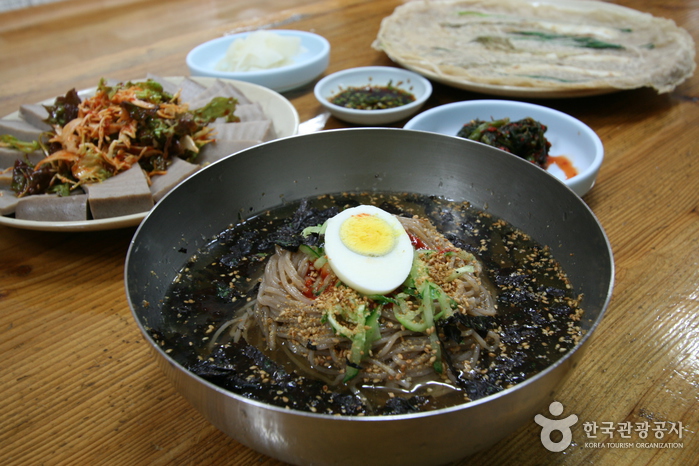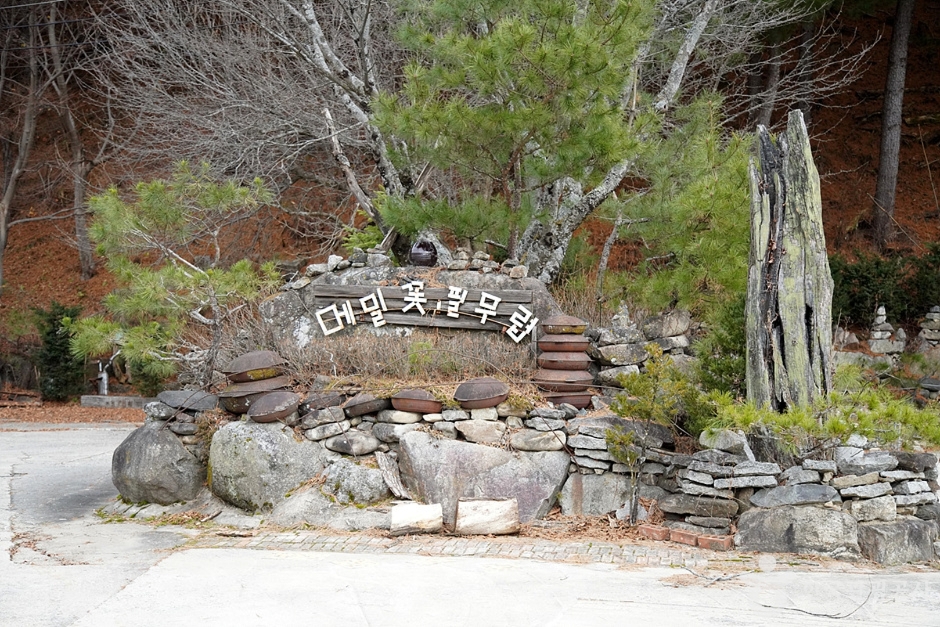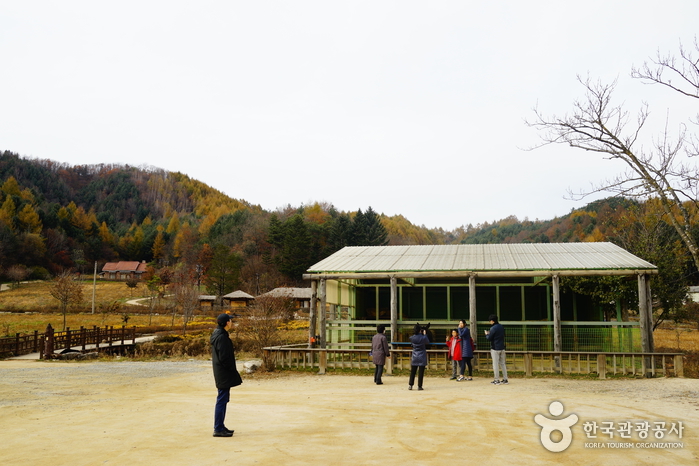Lee Hyo-seok Culture Village (이효석문화마을)
106.7M 2022-12-29
Wongil-ri, Pyeongchang-gun, Gangwon-do
+82-33-335-9669
Lee Hyo-seok Culture Village is the place where the author Lee Hyo-seok (pen name “Gasan”) was born and raised. The village is also the setting of the author’s novel "When the Buckwheat Blossoms,” one of the most celebrated Korean short stories to date.
In 1990, the village place was designated ‘first national cultural village’ by the Ministry of Culture and Tourism. The village is comprised of the author's birth house, a water mill, Gasan Park, Lee Hyo-seok Memorial Hall, and a buckwheat museum. During the peak of the blossoming season in early fall, the annual Lee Hyo-seok Cultural Festival takes place and visitors can enjoy the beautiful scenery of snow-white fields of buckwheat flowers.
Lee Hyo-seok Cultural Festival commemorates the modern Korean writer and features buckwheat-themed programs. Events include a Hyo-seok essay contest, traditional performances, a costume parade, a photo contest, and "When the Buckwheat Blossoms" plays and related performances. During the festival, visitors can enjoy makguksu (buckwheat noodles) and memil buchim (buckwheat pancakes) and tour the locations that appear in the famous short story.
Lee Hyo-seok Memorial Hall (이효석 문학관)
150.0M 2021-08-11
73-25, Hyoseongmunhak-gil, Pyeongchang-gun, Gangwon-do
+82-33-330-2700
Lee Hyo-seok Memorial Hall was opened on September 7, 2002 during the Hyoseok Cultural Festival to celebrate the literary contributions and display artifacts from the life of Lee Hyoseok (pen name Gasan). Many of the artifacts on display came from the Gasan Literature Group but some items were also donated from the children of Lee Hyoseok to commemorate the passing of their father.
Hyoseok Cultural Festival (평창효석문화제)
347.6M 2025-07-10
157 Ihyoseok-gil, Pyeongchang-gun, Gangwon-do
+82-33-335-2323
Korean novelist Lee Hyo-seok is from Pyeongchang, Gangwon State, and is known for his novels that combine stories with the beauty of nature. The Pyeongchang Hyoseok Cultural Festival, held every autumn in Bongpyeong, the setting of his famous work “When the Buckwheat Flowers Bloom,” celebrates his legacy and showcases the region’s beauty. The festival runs a variety of literary programs, such as an essay contest, a poetry event, and bookmaking. In the evening, there are small-scale literary and music performances to add to the romantic charm of the festivities. During the festival, the fields near the village are filled with white buckwheat flowers, creating a spectacular view as though they were waves of white snow rippling in the wind. A key highlight of the festival is capturing memorable photos against the backdrop of the buckwheat fields, which are the most cherished mementos of the event.
◎ The short novel “When the Buckwheat Flowers Bloom,” published in 1936, is a beloved work that captures themes of love and humor set against a buckwheat field. In September, Bongpyeong reaches the peak of its beauty with fields of white buckwheat flowers in full bloom.
Ssangdungine Gabyusl Sikdang (쌍둥이네가벼슬식당)
396.9M 2025-01-23
118-8 Ihyoseok-gil, Bongpyeong-myeon, Pyeongchang-gun, Gangwon-do
Though this restaurant specializes in chicken dishes, such as baeksuk (whole chicken soup) or dakbokkeumtang (spicy braised chicken), it is also known for gondeurebap (thistle rice), which is made into a bibimbap with makjang (Gangwon-style soybean paste). This restaurant, with its long history, has welcomed many famous figures, including athletes from around the world who competed in the Winter Olympics.
Hyoseok Culture Village Buckwheat Food Street (효석문화마을 메밀음식거리)
576.6M 2021-03-11
31, Gipung 3-gil, Pyeongchang-gun, Gangwon-do
+82-33-330-2771
The Hyoseok Culture Village is the place where author Lee Hyo-seok (penname “Gasan”) was born and raised. The village is also the setting of the author’s story "When Buckwheat Flowers Bloom,” one of the most celebrated Korean short stories to date. Since 1999, the Hyoseok Cultural Festival has been held here every September to commemorate the writer. Visitors to the festival can enjoy various foods and events as well as a replica of scenes from the book. For those that are searching for a more tranquil visit, avoid the month of September, when the buckwheat flowers are in full bloom. Don't forget to try all the different memil (buckwheat) dishes offered throughout the area all year round.
Hyundai Buckwheat Noodles (현대막국수)
590.4M 2025-10-23
17 Dongijangteo-gil, Bongpyeong-myeon, Pyeongchang-gun, Gangwon-do
Buckwheat, a staple in Gangwon State, is finely milled to make the base for Buckwheat Noodles. In Pyeongchang, where buckwheat fields are a common sight, numerous eateries specialize in these noodles. The signature dish here is the Pure Buckwheat Noodles, made exclusively from Korean-grown buckwheat. Its popularity stems from the noodles’ light broth, garnished with vegetables, offering a clean, non-overpowering flavor. For those who prefer a bit of a kick, the Spicy Buckwheat Noodles come with a tangy seasoning, customizable to taste. The accompanying side dishes are equally delightful, featuring items like Buckwheat Pancakes with buckwheat and cabbage, and Buckwheat Crepes stuffed with kimchi filling—each menu item invites one to savor the authentic essence of this cherished grain.
Hyoseok Literature Baengnigil Trail Course (효석문학 100리길)
898.4M 2023-06-23
14, Aegangnamu-gil, Pyeongchang-gun, Gangwon-do
Picturesque Pyeongchang, is a place where beautiful nature unfolds.
Pyeongchang, which retains its beautiful nature with four distinct seasons, is a place where the vast natural scenery spreads out like a panorama and is often called the "Asian Alps." About 65% of the total area of Pyeongchang is located in the highlands above 700 meters above sea level, and it is a clean natural area making it the best getaway destination.
Memilkkotpilmuryeop (메밀꽃필무렵)
1.0Km 2024-02-16
33-11 Ihyoseok-gil, Bongpyeong-myeon, Pyeongchang-gun, Gangwon-do
033-335-4594
Memilkkotpilmuryeop is a Gangwon local food restaurant renowned for its buckwheat delicacies. One of their standout dishes is the ganjang namul memil guksu (buckwheat noodles with soy sauce salad), a refreshing noodles featuring a subtly flavored soy sauce-infused broth. The restaurant places a strong emphasis on using buckwheat grown in-house and organic vegetables to enhace the taste of their offerings. Additionally, their memil jeonbyeong (buckwheat crepe) stuffed with minced kimchi and vegetables, and gamja mandu (potato mandu), are also must-try specialties.
Birthplace of Lee Hyo-seok (이효석 생가)
1.1Km 2020-11-20
33-11, Ihyoseok-gil, Pyeongchang-gun, Gangwon-do
+82-33-330-2771
Lee Hyo-seok Culture Village is the setting of the beautiful Korean story “When Buckwheat Flowers Bloom,” and also home to the author, Lee Hyo-seok (pen name Gasan). Registered as National Culture Village No. 1 in 1990 by the Ministry of Culture and Tourism, the village is the setting of the annual Hyoseok Cultural Festival in autumn. The village is made up of the birthplace of Lee Hyo-seok, a watermill house, thatch-roofed housing, Gasan Park, Lee Hyo-seok Memorial Hall, and restaurants serving food made with buckwheat.
Pyeongchang Mooee Arts Center (평창무이예술관)
2.0Km 2023-06-28
233, Saripyeong-gil, Pyeongchang-gun, Gangwon-do
+82-33-335-4118
The former Mooee Elementary School was transformed into Mooee Arts Center exhibiting works of noted Korean artists. It is located in the town of Bongpyeong-myeon in Pyeongchang-gun, which was the hometown of the famous Korean writer Lee Hyo-seok (1907-1942) and the background setting of his representative novel "When Buckwheat Flowers Bloom." Mooee Arts Center opened on April 18, 2001, after 2 years of preparation by Korean artists of various genres including the Western-style painter Jeong Yeon-seo, calligrapher Lee Cheon-seop, sculptor Oh Sang-wook, and potter Kwon Soon-beom.
The schoolyard has been turned into an outdoor sculpture park displaying large-scale sculptures. The arts center also offers hands-on experience programs and a chance to view the artists creating their pieces.








 English
English
 한국어
한국어 日本語
日本語 中文(简体)
中文(简体) Deutsch
Deutsch Français
Français Español
Español Русский
Русский